Pt 32 Alligators, Monkeys and the Creature from the Black Lagoon, OH My
A Curious History and the Wild side: This is Silver Springs Florida
Nestled in the heart of central Florida, Silver Springs is a place where history whispers from the cypress trees and crystal-clear waters reveal more than just their depths. I didn’t come here expecting to be enchanted—much less to lock eyes with a fox, stumble across forgotten cemeteries, or trace the footsteps of steamboat captains, Hollywood filmmakers, and mischief-making monkeys. But Silver Springs has a way of drawing you in, offering not just a scenic retreat, but a journey through time. From its vibrant natural beauty and glass-bottom boats to its layered and sometimes complicated past, this destination is far more than a postcard; it’s a living, breathing storybook. And lucky for me, I happened to wander right into the middle of it.
Need to catch up?
Pt 30 Singing Frogs, Fiery Sunsets & The Art of Mapping Adventure
Or, Start from the beginning
After a wonderful night’s sleep in our new destination (Silver Springs Florida), I set out for my early morning walk in the park. The air was soft and cool, the birds were beginning to stir, and the promise of a peaceful stroll filled me with anticipation. That was, until I came face to snout with a fox.
Not more than a foot away, we both froze—neither of us quite sure what to do. There was this sudden, electric stillness, as if time itself hit pause. It felt like just the two of us existed in that moment, locked in a silent exchange. Was it mutual respect? Wonderment? After what felt like an eternity in this time bubble, the fox made the decision for us, glancing sideways, then effortlessly leaping over a six-foot fence and vanishing as quickly as he’d appeared.I was left astonished, staring at the spot where he had stood, questioning whether the encounter had even happened.
I continued on, accompanied by the morning symphony of awakening birds. Silver Springs and the greater Ocala area are home to a dazzling array of birdlife. I spotted vibrant red cardinals flitting between branches and warblers darting through the underbrush as if playing a game of tag with me. I chuckled to myself thinking, cheeky little things.
At the end of the path, I stumbled across a strange little corner—part manicured, part mysterious. Tucked beneath tall pines and wrapped in quiet, it felt both tender and intentional, like a secret gently shared with those who happen to pass by. A small black sign read “Amber’s Corner,” adorned with painted white doves, swaying slightly in the breeze as if whispering something just out of reach.
The space was lovingly arranged: a birdbath, aged and elegant, stood like a sentinel to memory. A small angel statue knelt nearby, half-sheltered by blooming pink flowers and a soft blanket of greenery. Vines gently curled up a thin young tree, and a lantern hung nearby, perhaps once lit during evening visits. Perhaps it was a memorial, a sacred little tribute to someone named Amber. I tried to find out more, asked around—but no one seemed to know the full story. That somehow made it feel even more profound. A quiet place of remembrance, rooted in love, growing among the living things.
Just beyond the fence, in the quiet blur of the background, I noticed what appeared to be a small cemetery, almost hidden in plain sight, cloaked by nature with a whisper from the past. I felt an immediate pull to explore it, but the lure of a freshly brewed cup of coffee and a proper breakfast won out. That little graveyard would have to wait for another day’s adventure. Instead I turned my attention while waiting for my coffee to cool, to learn more about why this place is called Silver Springs and what makes it so special.
The Colorful History of Silver Springs
Silver Springs, located just east of Ocala along State Road 40, is a small but storied unincorporated community but still part of the Ocala metropolitan area, famed for its shimmering natural springs. The site boasts 30 artesian springs that collectively form the headwaters of the Silver River, which flows eastward into the Ocklawaha River, eventually joining the St. Johns River south of Palatka.
Long before tourists arrived, the Timucuan people lived here, thriving off the land and its pure, clear spring waters. Their time ended under the heavy boot of Spanish explorers, including Hernando de Soto, who came through in 1539, followed later by the Seminole people who made this region their own.
Once Florida was annexed by the United States, Silver Springs began drawing the attention of adventurous travelers. Long before highways and hotels, this meant slowly poling a small boat up the narrow, winding Ocklawaha River, gliding beneath thick canopies of cypress and Spanish moss. The effort was worth it—soon, Silver Springs became a vital distribution hub, with steamships replacing small boats to move goods from Florida’s plantations.

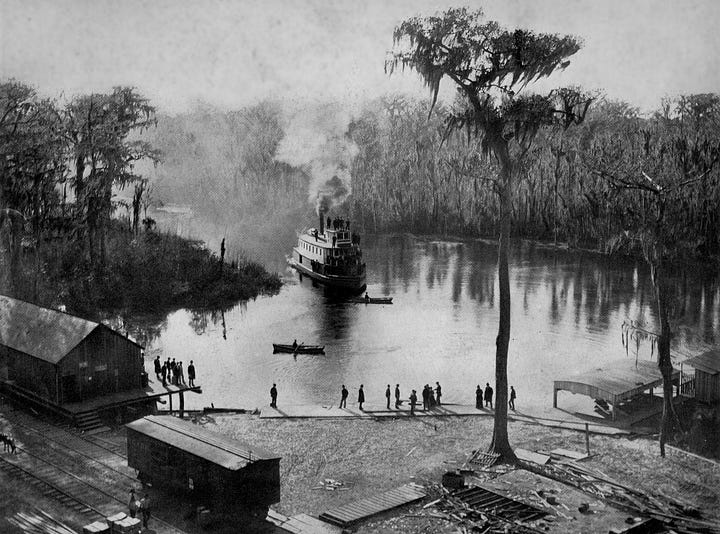
The steamboats didn’t just haul produce, eventually it brought curious tourists, too. The wild beauty of the area was so celebrated that multiple companies sprang up offering torch-lit jungle cruises, adding an exotic flair to the voyage. When the railroad arrived, even more visitors poured in, making Silver Springs a mandatory stop on the grand tour of Florida.
And then came the real magic: in the 1870s, Hullam Jones and Phillip Morrell, in a stroke of creative genius, replaced the bottom of a small boat, possibly a rowboat or canoe (depending on which version of the tale you believe) with a pane of glass. It was a simple idea, but it completely transformed the way people experienced the springs. Just like that, the glass bottom boat tour was born, offering a window into an underwater world that had remained hidden for centuries.
Tourism exploded. Word spread fast, and curious travelers began arriving from all corners of the country. For many, it was their first glimpse into the crystal-clear depths of an artesian spring. Through the glass, they could see swaying aquatic grasses, ancient limestone formations, darting fish, and even bubbling sand boils, natural vents where the spring water surged from underground. It was like watching the earth breathe.
By the 1880s, demand had grown so high that a 200-room hotel was built near the main spring to accommodate the influx of guests eager to soak in the full experience. It wasn’t just a vacation, it was a spectacle, an adventure, and a touch of science rolled into one surreal ride. For many visitors, floating over the water was as close to magic as they’d ever get.

The 20th century brought even more excitement. Snake expert Ross Allen established the Silver Springs Reptile Institute, famously milking venomous snakes for research and hunting for a cure to snakebites. And if venomous snakes weren’t exciting enough, how about monkeys? The operator of the Jungle Cruise boats (his name was Colonel Tooey, if you’re curious) released Rhesus macaques onto an island to create a more thrilling tourist experience. The monkeys had other plans. Not only did they not stay put, but they multiplied and now freely roam the region (today) proof that tourists aren't the only ones swinging through these trees.
Hollywood, of course, couldn’t resist Silver Springs. Do yiou remember the orginal movie Creature from the Black Lagoon? Well, it was filmed here, along with over 20 other movies. The park was the backdrop for six Tarzan films starring Olympic swimmer Johnny Weissmuller in the 1930s and 40s. Later, Lloyd Bridges brought his underwater adventures to the springs in episodes of Sea Hunt, shot in the 1950s and 60s.
Of course, the silver sheen of Silver Springs also reflects some darker moments in history. During the era of segregation, the so-called rule of “separate but equal” was in full effect—though in reality, it was never equal, especially not for the people of colour and the African American community.
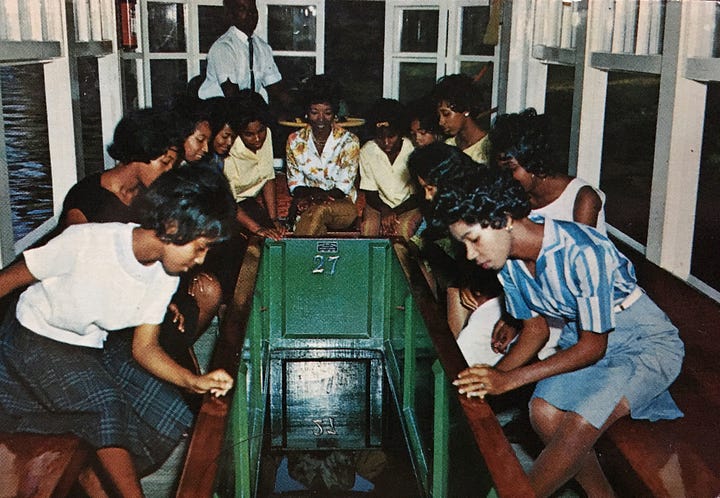
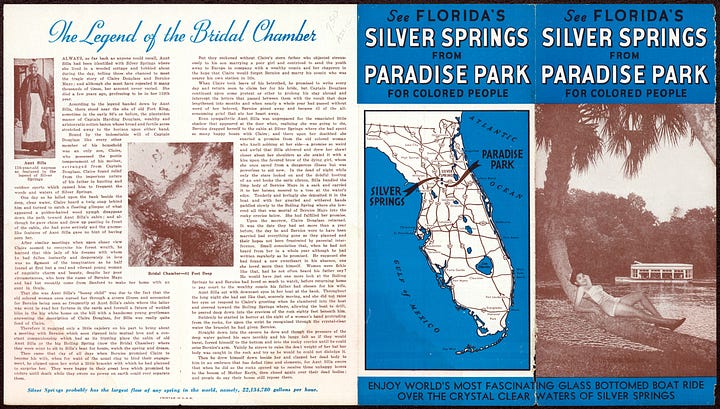


A separate facility known as Paradise Park was established about a mile away for African American visitors, who were prohibited from enjoying the main attractions at Silver Springs. Paradise Park offered similar experiences—glass-bottom boat rides, swimming, picnicking, a jungle cruise, petting zoo, and even a dance pavilion—but it was always a shadow of what was available to white guests. It quietly closed in 1969, when desegregation finally reached Silver Springs, allowing all visitors to enjoy the park equally.
The 1960s ushered in a period of massive expansion, ballooning the park to 3,900 acres. In 1972, Silver Springs was officially designated a National Natural Landmark by the U.S. Department of the Interior and National Park Service. The attractions grew to include Wild Waters, a seasonal water park, alongside a petting zoo, a Jeep safari, the Lost River Voyage, an antique race car museum, and even a white alligator exhibit.
But like all grand attractions, Silver Springs had its heyday… and then came the slow fade. New mega-parks like Disney World, SeaWorld, and Universal Studios lured tourists elsewhere with their bright lights and shinky objects. Add to that modern development, fertilizer runoff, and septic leakage, and the fragile spring ecosystem began to suffer. Algae choked the once-clear waters. The magic dimmed.
In September 2013, after nearly 135 years, Silver Springs closed as a private attraction. But it didn’t stay down for long. Just one month later, in October, after some renovations, the state reopened it as Silver Springs State Park, complete with cabins, campgrounds, and miles of nature trails. This transition marked the integration of the historic Silver Springs attraction with the adjacent Silver River State Park, creating a unified park aimed at preserving the area’s natural beauty while offering enhanced recreational opportunities.
The State of Florida got serious about restoring the ecosystem—removing invasive species and replacing noisy Jeep tours with quieter, eco-friendly tram rides. Today, you can canoe, kayak, or paddleboard… but no swimming is allowed. And this girl? Very happy about that. Let’s save the ecosystem.
Another reason why we should abide by ths rule, brain eating amoebas. Naegleria fowleri, a.k.a. the brain-eating amoeba, thrives in warm freshwater environments. Though rare, it’s very real and very deadly. It enters the body through the nose (not by drinking or skin contact), travels to the brain, and causes Primary Amebic Meningoencephalitis (PAM). Almost all cases are fatal. The CDC reported 164 infections in the U.S. between 1962 and 2023 with only four survivors. Florida alone recorded 40 cases between 1962 and 2022. I remember reading that in one particularly hot year, there were 35 reported cases, though the numbers vary depending on the source and year.
Either way, I think we can all agree not worth the dip, even for that perfect (albeit stupid) Instagram shot. So yes, enjoy the park. Paddle, picnic, hike, and soak in the beauty. But let’s keep our noses dry, shall we?
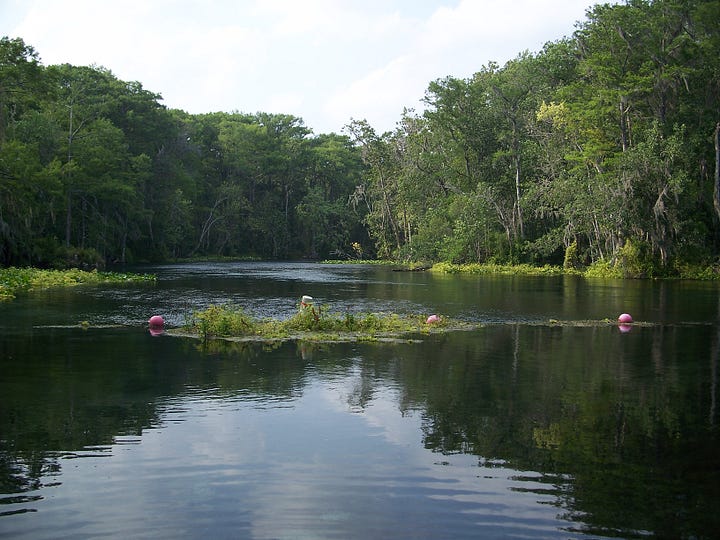

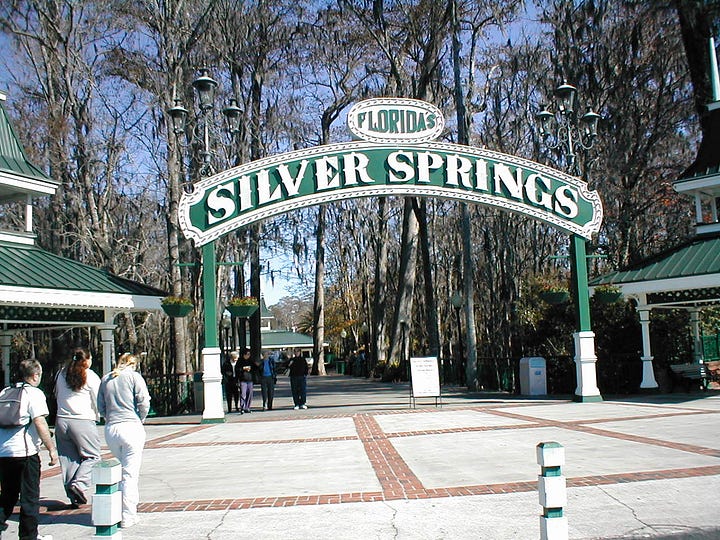
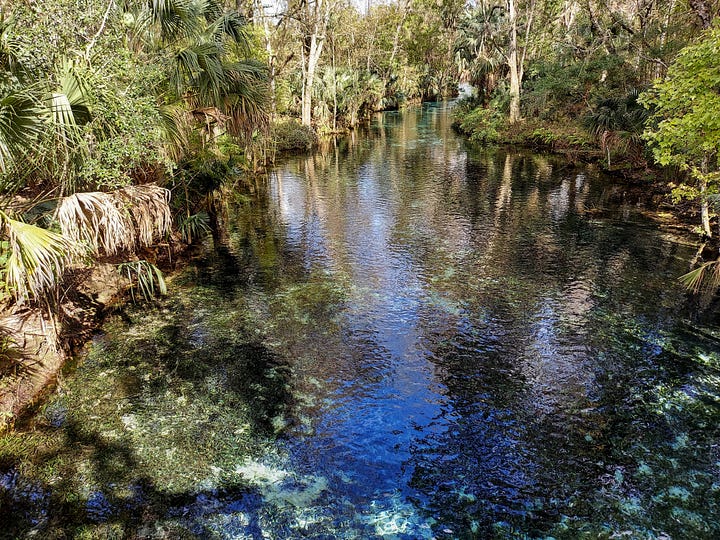
Millions have been poured into spring restoration projects to reduce harmful nitrates and bring back the water’s natural clarity. And with the Florida Park Service now managing it, we can rest assured that this delicate ecosystem is in capable hands—preserved and protected for generations to come.
The amusement rides may be gone, but the pristine water remains. And I like to think the wildlife let out a collective primal exhale now that they no longer have to dodge engine noise or camera-toting tourists barreling through on loud Jeep tours. Yes, I truly believe Mother Nature finally got her vacation.
While the park has shifted toward more eco-friendly practices like replacing the Jeeps with quieter tram rides and prohibiting swimming to protect the fragile ecosystem. The glass-bottom boats remain a cherished tradition. These iconic vessels still glide gently across the water, offering visitors an unparalleled view into the hidden world below. Through the glass, you can spot schools of fish, turtles drifting along the sandy bottom, and even historical artifacts resting silently on the riverbed, all without disturbing the natural habitat.
So, while some attractions have been retired to preserve the park's natural beauty, the glass-bottom boat tours persist—standing as a tribute to Silver Springs’ rich history and its thoughtful evolution into a model of sustainable tourism.
Although Silver Springs may not be a city, it holds a vibrant community and a rich, winding history—preserved, protected, and ready for the next curious wanderer to discover. As for me, I was already lacing up my hiking shoes and eyeing the trails, ready to leave civilization behind once more and walk straight into the wild heart of Florida. But that is a story for another day.
If you have not subscribed yet, why not? If you are subscribed, you will be alerted as soon as the next story drops and it will come effortlessly into your inbox or an alert on the app every Wednesday morning. So, hit that blue button right there and subscribe now. Thank you!
Once you do that and are feeling all kinds of fuzzy feels, how about tipping the Tipsmobile?
If my adventures and stories are bringing a smile to your face, why not throw a little fuel in my tank to keep the wheels turning —literally! Even creativity needs a top-up now and then! Your support keeps me inspired, and rolling down the road. Thanks for being part of the journey!
Need to catch up?
Pt 30 Singing Frogs, Fiery Sunsets & The Art of Mapping Adventure
Pt 29 "You can check-out any time you like, But you can never leave.”
Or, start from the beginning
Thank you for tuning in and reading this. I super appreciate you.
~Karen

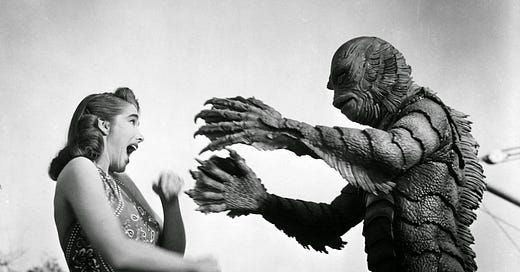




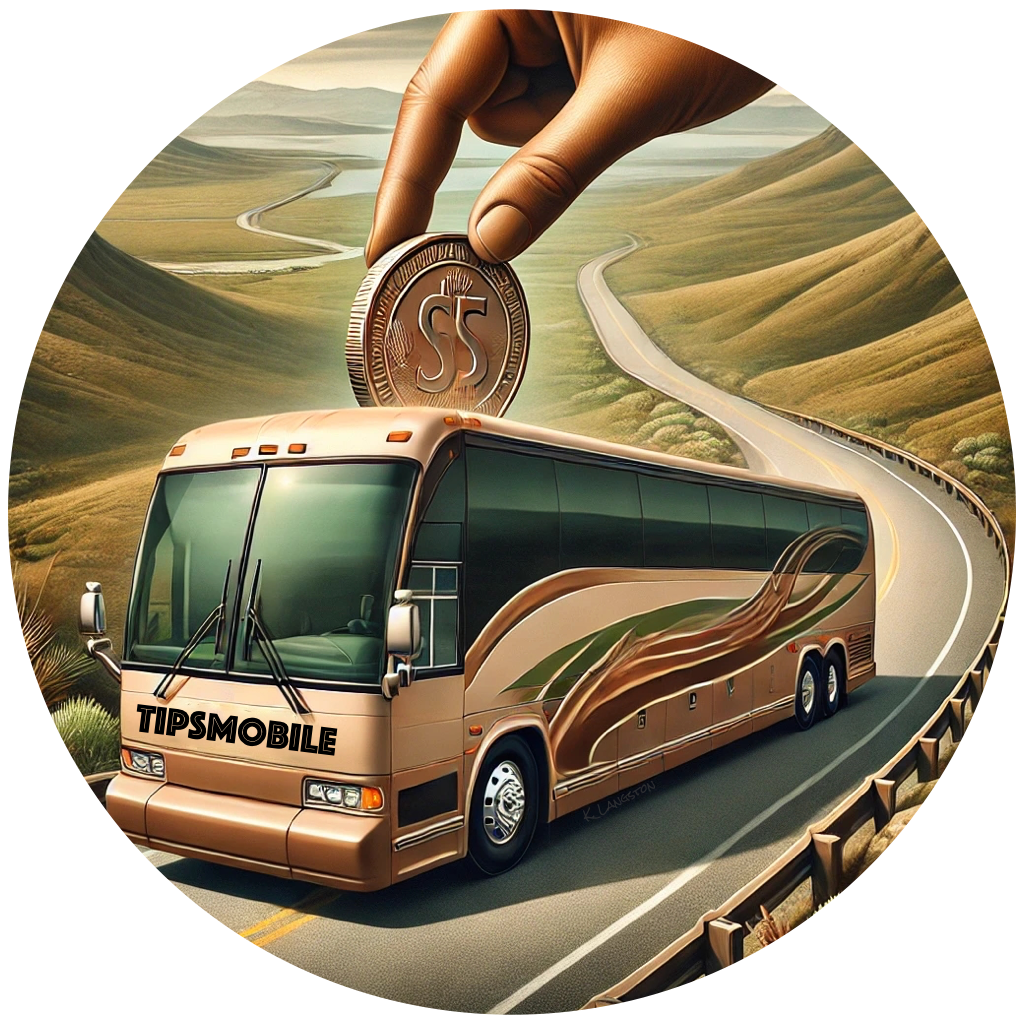
Very cool!
Over a decade ago, I was walking down the path on Bridges Street that's close to the highway in Morehead City. A fox ran across the highway and path about 3 or 4 feet ahead of me. Whew! I was so relieved that I wasn't closer! 🦊